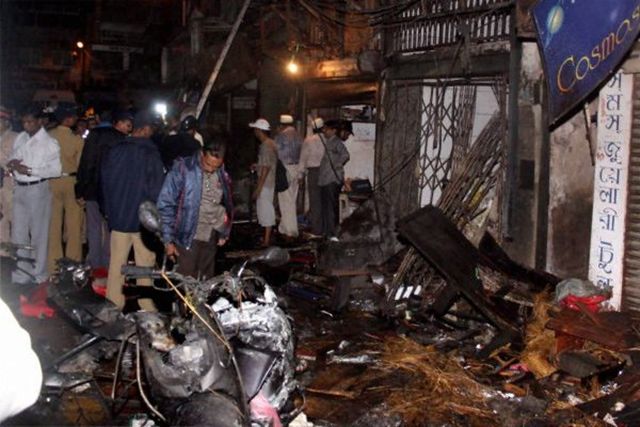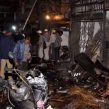Mumbai Outraged Once Again: India Blinks, Blames Homegrown Terror
By:

Executive Summary:
In the weeks following the July 13 bomb explosions in Mumbai, responsibility for the attacks has yet to be determined. Investigative agencies have not yet pinpointed a suspect nor has any terrorist group claimed the blasts as its own doing, perhaps in order to complicate the investigation or delay the process. The triple blasts, which killed 24 people and injured over one hundred, mark the first major terrorist attack in Mumbai since the November 2008 attacks orchestrated by Pakistan’s Lashkar-e-Taiba (LeT). Current indications point the finger toward the Indian Mujahedeen (IM), a terrorist group with connections to LeT, due to the use of IEDs made of ammonium nitrate and fuel oil (ANFO) as well as the remote-controlled detonation of the bombs, which were common characteristics of IM terrorist acts across India between 2007 and 2008. While responsibility for the blasts remains unclaimed, it is the Indian intelligence agency that is bearing the brunt of guilt and scrutiny, as it is clear that stepped-up security measures that were put in place following the November 2008 attack did little to avoid another deadly situation. And while the Indian government has, in the past, been quick to blame Pakistan for harboring terrorist groups, such rhetoric has been missing in the weeks since July 13. This could be a sign of the neighboring countries’ new approach to combating terrorist organizations in the region.
Introduction
Weeks after the July 13 triple bomb blasts that stunned India’s commercial capital, Mumbai, once again, investigating agencies have yet to pinpoint the terrorist group or organization behind these deadly blasts. Three bombs went off within minutes killing 24 people with over one hundred injured at Dadar’s Kabutarkhana, the Opera House and Zaveri Bazaar (Daily News and Analysis (Mumbai) July 25). Forensic investigation confirms the use of IEDs made of ammonium nitrate and fuel oil (ANFO) and ball bearings (Economic Times/Indo Asian News Service, July 18). And it is evidently clear that the blasts were triggered by timer devices and not by remote-controlled devices.
India’s intelligence apparatus came under severe scrutiny this time as terror modules have managed to strike again in the heart of Mumbai despite stepped up security measures that were put in place following the November 2008 Mumbai siege. Pakistani based Lashkar-e-Taiba and Pakistan’s intelligence agency, ISI, were blamed for masterminding the 2008 Mumbai attacks.
Surprisingly, no terrorist organizations have claimed responsibility so far, perhaps for the purpose of complicating investigation procedures and or to delay follow up actions by the agencies. For the first time, the Indian government and intelligence agencies have refrained from naming either any Pakistan based terror group or any homegrown groups so far. However, the direction of the ongoing investigation is moving toward Indian Mujahideen (IM), which is largely nurtured by the Pakistan based Lashkar-e-Taiba (LeT) and received explosives training from the Bangladesh based Harkat ul Jihadi Islami-Bangladesh (HuJI-B).
The Indian Mujahedeen, largely comprised of outlawed Student Islamic Movement of India (SIMI) cadres, had claimed responsibility for a number of similar terror acts across India between 2007 and 2008 in which they used mostly ANFO based IEDs and timer devices to trigger blasts in many Indian cities, a technique they learned from the HuJI-Bangladesh (Terrorism Monitor, January 21, 2010). Since the Pune Germany Bakery blast of February 2010, IM has claimed at least two terror attacks in Delhi and Varanasi. In September of last year, bike-borne gunmen attacked a tourist bus, injuring two Taiwanese men outside Delhi’s historic Jama Masjid. Again in December of that year a bomb exploded on the banks of the Holy Ganges River in Varanasi. Now the National Investigating Agency (NIA) along with Mumbai police has been connecting the dots to determine whether or not those low intensity explosions have links to the July 13 Mumbai blasts.
Arguably, ANFO can be used by any fringe group with a subversive motive, as ammonium nitrate is readily available in India and mostly used for mining purposes. For this very reason, the involvement of right wing extremist groups such as Avinav Bharat and Sanatan Sanstha is also being investigated. Past experience, however, shows that these groups have limited and low intensity capability and have only perpetrated retaliatory attacks against Islamic religious places and symbols. Their involvement, therefore, could certainly be ruled out.
IM-LeT Handiwork?
The recent bombings have all the markings of Indian Mujahideen, as the explosives used and the tactic of synchronized bomb attacks in crowded places put the needle of suspicion squarely on the IM, whose top leadership is presently holed up in neighboring Pakistan. Two new offshoots of IM have been under intelligence radar for quite some time: ‘Bullet 313 Brigade’ and the Jama’t Ansar-ul Muslimeen (Sakal Times (Pune) July 16; Rediff.com, July 18). These shadow organizations act as covers for IM, and more importantly, scout new talents and coordinate fund collections in Uttar Pradesh, Andhra Pradesh, Kerala and in Karnataka. If intelligence agencies are to be believed, these units are under the direct control of fugitive IM operatives in Pakistan who fled India after the countrywide crackdown on IM hideouts in 2008. Many IM operatives were arrested during that time from Gujarat, Kerala, Maharashtra, Madhya Pradesh, Delhi and Uttar Pradesh. As many as 15 top level operatives are still at large including Iqbal Shahbandari, Riyaz Shahbandari, Abdus Subhan Quresi and Mohsin Chaudhary.
The arrest of Danish Riyaz, IM’s treasurer and recruiter, on June 21 in connection with the 2008 Ahmadabad blasts sheds light on the Lashkar-e-Taiba, Taliban and IM’s evil designs against India. The email communications of Riyaz with other arrested and absconding terrorists, including a man named Haroon, Mohammed Safikul and Abu Faisal, have revealed conspiracies hatched against India across international borders. Haroon, a suspect in the July 13 Mumbai blasts, is believed to have been in touch with Taliban leaders in Pakistan. The Gujarat crime branch police is presently investigating whether or not Haroon sent 10 new recruits, as planned, to the special Taliban training program (India Today, July 18). Another revelation came from Mohammed Safikul, a LeT operative arrested in Malda (West Bengal) in January 2009, who told interrogators about LeT’s new recruitment drives in the Eastern Indian states of West Bengal, Bihar, Assam and Tripura (Hindustan Times, July 18).
A Possible HuJI Link
Just before the July 13 blasts, Bihar state police had detained two Harkat ul Jihadi Islami (HuJI) suspects identified as Riyazul Sarkar and Mahtab Alam, along with multiple SIM cards, cell phones and documents written in the Marathi language (spoken in Mumbai [Maharashtra]). The two men are under investigation for their possible links with the Mumbai serial blasts (Times of India, July 18). Another HuJI operative Jalaluddin Mullah (a.k.a Babu Bhai) who has emerged as key linkman between HuJI and IM earlier and now in custody, is too under interrogation. It is believed that he might have some vital clues that can solve the Mumbai mystery (Hindustan Times, July 20). According to available information, Jalaluddin was in touch with one Khurram Khayyam, a key recruiter for HuJI-B and a key linkman between various terror groups operating out of Bangladesh, for example, Lashkar-e-Taiba and Jama’atul Mujahideen Bangladesh.
Based on the investigations so far, especially following revelations from Haroon and Riaz, the Mumbai Anti-Terrorism Squad (ATS) and NIA have been working on specific leads and are now engaged in a massive search operation inside the Dangs forests on the Gujarat-Maharashtra border for six absconding IM operatives from West Bengal and Gujarat.
Reported sightings of IM’s Riyaz Shahbandari, who fled to Pakistan long ago, on the outskirts of Mumbai days before the blast as well as the Nepal police arrest of a suspect named Mohammad Zaheer for alleged involvement in the July 13 Mumbai blasts added fresh leads in the ongoing investigations, but so far no definite link has been established (Mumbai Mirror, July 23).
Meanwhile, the ATS and NIA have unleashed a countrywide search and sweep operation to nab the culprit behind these deadly terrorist attacks.
India-Pakistan Ties Amid Terror
The latest Mumbai blasts took place on the eve of the scheduled July 27 talks between the foreign ministers of the two countries in Delhi. Surprisingly, the usual blame game between India and Pakistan has been missing and war rhetoric has taken a backseat for now. India has in the past accused Pakistan of harboring violent terrorist groups and unleashing a proxy war. Following the November 2008 Mumbai siege, direct accusations emanated from India and there were talks of a surgical strike targeting terror infrastructures inside Pakistan. [1] This time, however, both political and media fraternities from each side have abstained from confrontation.
Despite this posturing, the Indian Home Minster made it clear during the fourth meeting of SAARC Home/Interior Ministers in Thimpu (Bhutan) recently that terrorist groups have flourished because of the support they have found from both state and non-state actors, and no country can escape its responsibility by blaming non-state actors for terrorist activities emanating from its soil, with an obvious reference to Pakistan (The Hindu, July 23). Raising the issue of “safe heavens” and “terror camps”, he cautioned that Pakistan owes a “legal and moral responsibility to its neighbors” and to the world to suppress those non-state actors and bring them to justice.
By not blaming Pakistan for the latest terror strikes, it is amply clear that India is attempting to place psychological pressure on Pakistan to work toward dismantling terrorist infrastructures, to cooperate in solving the pending 2008 Mumbai case and, last but not least, to take serious action against those on the revised fugitive lists.
The inevitable question is now, if a LeT-IM nexus is be found to be behind the latest Mumbai blasts, then what would be India’s response? Whether India should at all engage with Pakistan diplomatically in the future or go on a hot pursuit targeting Lashkar-e-Taiba and other anti-Indian terror organizations inside Pakistan is still unknown. Plausibly, India’s response would remain calculated to keep the diplomatic channel open and to avoid any military confrontation at the Western borders.
Looking at the latest terror investigations it seems that homegrown terror is thriving despite the government’s repeated denial that Indian Muslims are radicalized enough to perpetrate terror on their own. The Indian Home Minster himself admitted that these “indigenous terror groups” are no longer fledgling outfits (Times of India, July 27). However, the complicity of Lashkar-e-Taiba and Harkat ul Jihadi Islami in nurturing and directing these so called homegrown terror organizations should not be overlooked.
Note:
1. Read the Interview of External Affairs Minister Pranab Mukherjee, “India has right to protect its territorial integrity: Pranab,” NDTV.com, December 02, 2008.




